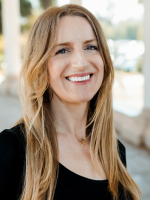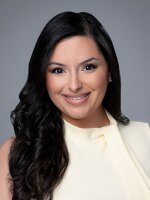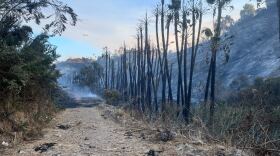March 2022 marks the second anniversary of COVID-19-related cancellations, shutdowns, and uncertainty for performers, organizations and venues in the performing arts sector.
According to the City of San Diego's Arts and Culture Citywide Impact Report, the number of funded events and nonprofits decreased in 2021 — as did the number of San Diegans who engaged in the arts and culture industry as participants. In the nonprofit sector as a whole, grant funding did increase overall, but new data from the University of San Diego's Nonprofit Institute reveal that revenue from fundraising events and earned revenue, like ticket sales or membership dues, continued to decrease in 2021.
'That opportunity of given time'
Around the same time that Gov. Newsom issued the first stay-at-home order, the San Diego Gay Men's Chorus was dealing with a COVID-19 outbreak of its own. Executive director Jeff Heine said that in March of 2020 they — like most people — weren't thinking about how they'd weather two years of a pandemic.

"At the time, when we went into lockdown back in March of 2020, I think everyone kind of thought this was going to be a temporary thing. We were all eager and willing to go through the protocols that had been recommended to us, that we were hearing on the news, of what we had to do to shut down, but thinking that this would be a very short term — less than a month and we'd all be back to work. And I don't think we really understood the impact until after a couple of months. And then it did become a concern about what do you do when your very artistic product is a superspreader event with our singers performing together being in an audience?
"Now that we're into two years of this pandemic , I think the challenges for us right now — and I don't know if it's a challenge or an opportunity … I would like to look at it as an opportunity that we now have a chance to rebuild after the long hiatus of the pandemic shutdown of not only just rebuilding, but looking at what we've done, looking at how our organization is run, looking at the shows that we produce, and is this finally that opportunity of given time where we can actually take a look at our future and see if we can emerge. In other words, what's the new normal for us as we emerge from this? What does our new normal look like? And that doesn't have to be a challenge. It can actually be a very exciting thing. I think for me, how I would define our new normal or rebuilding to a new normal is looking at the performances that we do. What can we do to maintain this virtual component that we've all had to learn the hard way to manage and to produce?"
—Jeff Heine, executive director, San Diego Gay Men's Chorus
But what was it really like as a performer during these last two years, as the evolving pandemic changed their ability to work? KPBS spoke with several other performers from San Diego, starting with Sarah-Nicole Carter, a mezzo soprano with the San Diego Opera.
'I would literally suck mask into my mouth'
Carter is also the cofounder and artistic director of the FF Collective, a woman-led performing arts group in Southern California.

"Your body is your instrument, right? So just like dance, of course, your body is your instrument. So if you get sick, you don't make money. And our contract structure is built like that. So you get paid by stepping foot onto the stage. You don't get paid for the six months you take to learn a role. You don't get paid for the weeks of rehearsal beforehand. You get paid when your foot touches the stage. So when something like a pandemic happens globally and you're not allowed to open your mouth really, and then you're classified as a superspreader because you're an opera singer, and then you're told your job isn't essential, that's a lot of blows all to take at once.
"Most of the people in my industry who were working full time as opera singers, that just went away for two years. So the opera industry is now undergoing a lot of changes because a lot of singers have found other careers that they found as fulfilling or more financially stable, less stressful, maybe more stressful in different ways. But the biggest takeaways from me from the pandemic were the industry is going to have to change in some ways to better serve its artists.
"Singing in a mask has been a really interesting challenge. I think different singers react to it in different ways depending on their technique. I don't love it. Initially when we had the cloth masks, a lot of times you'd breathe them into your face, which is why singing masks became a thing. You didn't really have the ability to open your mouth and jaw freely and move freely. There were plenty of times where I would literally suck mask into my mouth while we were singing — when I was taking an inhalation. So a lot of people started developing these singers' masks. Those allow for you to do free jaw, face, anything you need to do with your body to actually do our job. But there's also a huge difference in what the audience is hearing when it's a masked singer or a masked chorus."
— Sarah-Nicole Carter, mezzo soprano, San Diego Opera
'I saw so many students and professionals leave ballet completely'
Ballet dancers may not need to sing through special masks but like an opera singer, their bodies are their instrument and their livelihood.
Stephanie Maiorano is a ballerina in the San Diego Ballet. She's been with the company for eleven years, and training as a ballet dancer most of her life.
RELATED: A Dancer On ‘Giselle,’ Forgiveness And A Life Upside Down

"The last two years have kind of been a blur. I almost don't remember what it was like before we had these two years. I mean, for as long as I can remember, since I was eleven, I was going to dance studios every day, having performances every couple of months. And I really took it for granted because I feel like that's just the life of a dancer. You get up, you go to the studio, you take class, you rehearse, and then you go into a theater on stage and you perform.
"So when that was all taken away from us so quickly, it was kind of a super surreal experience because as dancers, how do we stay in shape? You need enough space to kick your leg in the air, to jump, to turn. And a piano player can still play their piano in their home. A singer can still sing, but a dancer, especially a ballerina, they need somewhere to wear their pointe shoes. They need to keep training and keep dancing. Otherwise you lose it.
"It was really sad because the first year of the pandemic, I saw so many students and professionals leave ballet completely — quit because they couldn't take the thought of trying to get back into shape. But what I was surprised about was how resilient I was and the dancers that I know were. We immediately got to work trying to find ways to find classes online.
"It was hard not performing. It was hard not being in a theater and stopping and thinking about all these things. It gave me a new perspective on what's so important about having an audience gather and for me to share this passion that I have."
—Stephanie Maiorano, dancer, San Diego Ballet
Posture adjustments, tuning and camera angles
One of the things we heard from performing artists over the last two years is that part of how they make ends meet is through teaching lessons. And for some, teaching is their primary passion, and when you're used to physically sharing space with your students, a lot gets lost in the ether. Carol Seefeldt is a piano teacher, and co-founder of the San Diego Music Academy.

"All of us pretty much had to improvise overnight with the lesson equipment set up. So we did initially experience a slight drop in the enrollment. There were a variety of reasons. And some families were just — parents very sadly lost their jobs and they don't have that income anymore. And also a lot of students have now increased screen time.
"Teaching on Zoom, I would say definitely had disadvantages but also perks as well. So for regular Zoom lessons, depending on the camera angle — for my own lessons especially — and the quality of the sound, if the students were on a computer or phone, does make a big difference. It could be really hard to hear the lower and the higher pitches and it's almost impossible to tell the balance between the hands.
"For beginners, I think it was definitely a challenge because we were not able to do any posture corrections for young beginners. They mainly depend on the teacher physically being there for the guidance. I'm a piano teacher so that's the area I can speak for, but I also know for other instruments like string players, there is that posture as well. There's the tuning — a lot of teachers tune for their young students. Woodwind instruments will be how the joints align and things like that. So that's definitely a challenge.
"Now that we see things opening up, we do see an increase of people turning to music, especially during the time of change."
— Carol Seefeldt, piano instructor

In part two, we will explore how the past two years of the pandemic have impacted the theater. "Now here we are two years later and the world has changed. Spent a long time just sitting and trying to figure out how to make art." Actor Joy Yvonne Jones will share her experience in part two, airing Wednesday on KPBS Midday Edition — plus, a Broadway actor and dance captain, a set and costume designer and a local theater company.







